Chapter 6.6: Ceramics
Traditional ceramics are ubiquitous to our everyday life and overall development as humankind. Archeologists trace ceramic origins back thousands of years, from marking history with artistic figurines to more practical uses like storing grains in ceramic vessels. Here, we will walk you through the history of ceramics, its practical uses, and the different types.
What is Ceramics?
Ceramic objects are made by combining naturally occurring raw materials, such as clay, earthen minerals, and water, and shaping them into forms using hand-building, wheel-throwing, or mold-casting techniques. Once shaped, the object is fired in a kiln at a high temperature. Firing ceramics makes them hardened and heat resistant. Ceramic objects are used as building materials, functional dinnerware, decorative sculpture, and more.
“Ceramic” can be used as an adjective, or as a noun to describe the clay object once it has been fired. There are a number of techniques used in ceramics, depending on the final project you have in mind. Ceramic objects can be built by hand using slab, coiling, and pinching techniques. Potters also use wheel throwing to create symmetrical pottery and slip casting to create multiples of one object.
What is: Ceramic Art? | HENI Talks (4:10)
Traditional Types of Ceramic Pottery
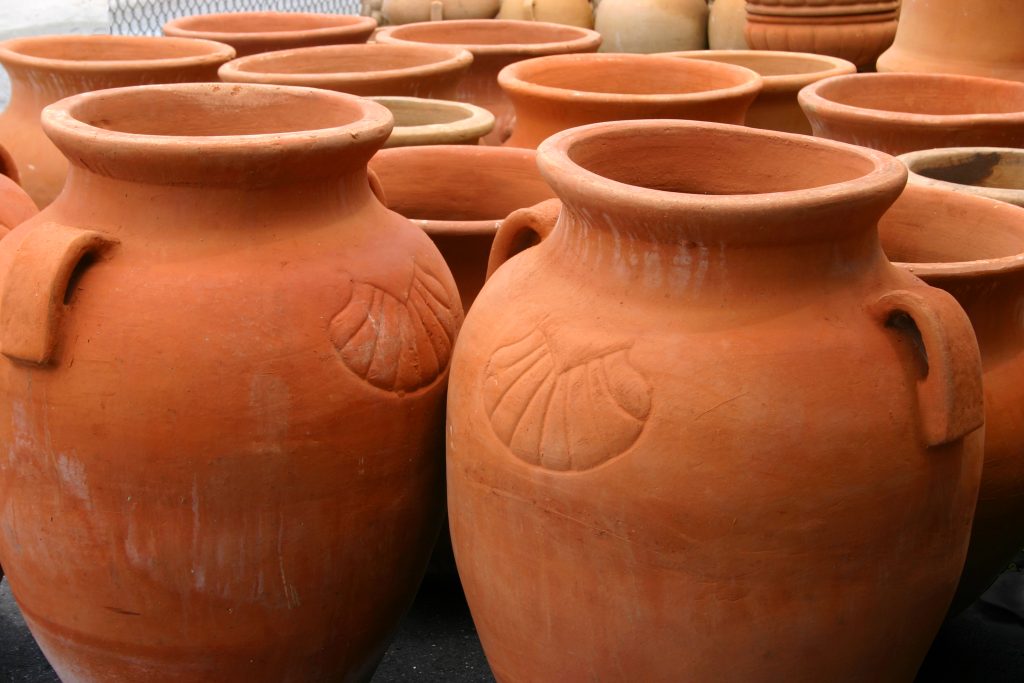
Common examples are earthenware, stoneware, porcelain, and bone china. Clay is one of the widely available raw materials for creating ceramic objects. Different types of clay and combinations of clay with different variations of silica and other minerals result in different types of ceramic pottery.
Earthenware
Earthenware is pottery that has not been fired to vitrification, which is the process of crystalline silicate compounds bonding into noncrystalline glass compounds. This makes the pottery more porous and coarser to the touch. Earthenware pottery was the most common type of ceramics until the 18th century. Terracotta, a clay-based and unglazed ceramic, is a common type of earthenware. Today, we commonly see planters made from terracotta, along with bricks, water pipes, and more.
Stoneware
Stoneware is a vitreous or semi-vitreous ceramic, meaning it is coated in enamel to make it appear glassy and to make it nonporous. Stoneware is fired at high temperatures compared to other ceramics. It is typically an earth-tone color because of impurities in the clay and is normally glazed.
Porcelain
Porcelain ceramics are made by heating materials, generally kaolin clay, in a kiln to temperatures between 2,200 and 2,600 degrees Fahrenheit. Porcelain is a very heat-resistant and strong material compared to other types of ceramics. This is because of the vitrification process and formation of the silicate mineral mullite when fired. Common types of porcelain ceramics are bathroom and kitchen tiles, vessels, decorative sculptures, and more.
Bone China
Bone china, also known as fine china, is a type of porcelain that is known for its translucency, high strength, and chip resistance. It is made from a combination of bone ash, feldspathic material, and kaolin, and was developed by English ceramicist Josiah Spode around 1800. Because it is such a strong material, bone china ceramics can be shaped into thinner forms than porcelain. It is vitrified but is translucent due to differing mineral properties.
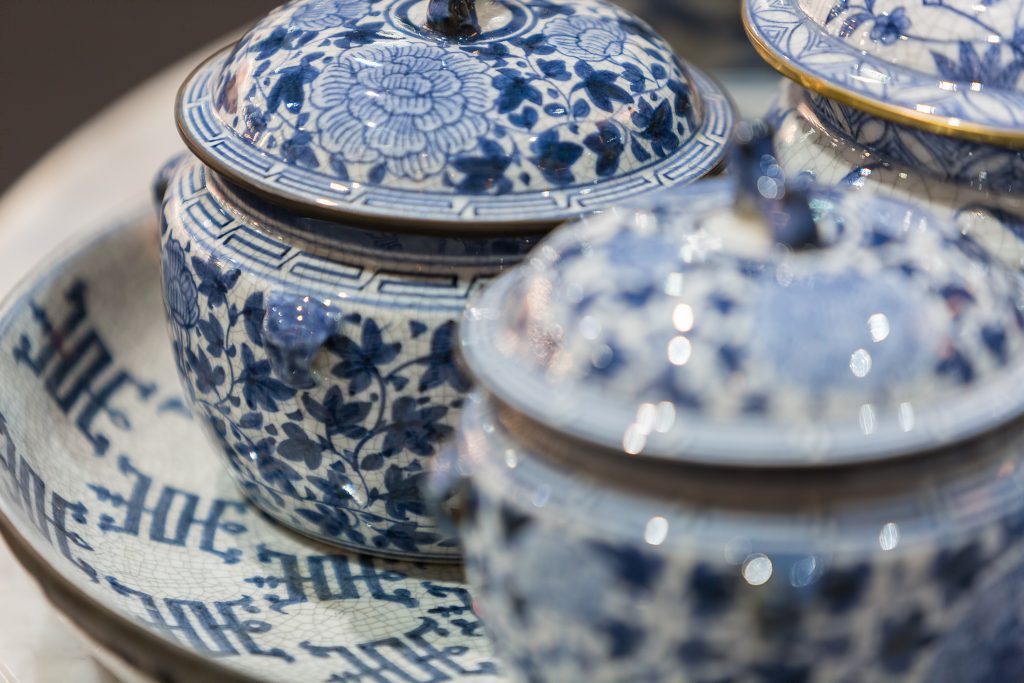
Types of Ceramic Materials
Ceramics are omnipresent from our kitchen pantries to tool closets. They go far beyond the simple use of a ceramic vessel or sculpture and are applied in everything from science to mechanical engineering.
Tile
Ceramic and porcelain are two common types of tiles. Ceramic tile is made from a combination of silica, minerals, and clay that is shaped and fired in a kiln. Ceramic tiles use a mix of coarser clay with a smaller ratio of kaolin clay and are fired at lower temperatures as compared to porcelain—generally no higher than 1,650 degrees Fahrenheit.
The clays used to make ceramic tile are less dense than porcelain clays, which means ceramic tiles are more vulnerable to cracking and breaking. Ceramic tile is also more porous and prone to water infiltration than porcelain tile. If you are working on a budget, Ceramic tile will be much less expensive than porcelain.
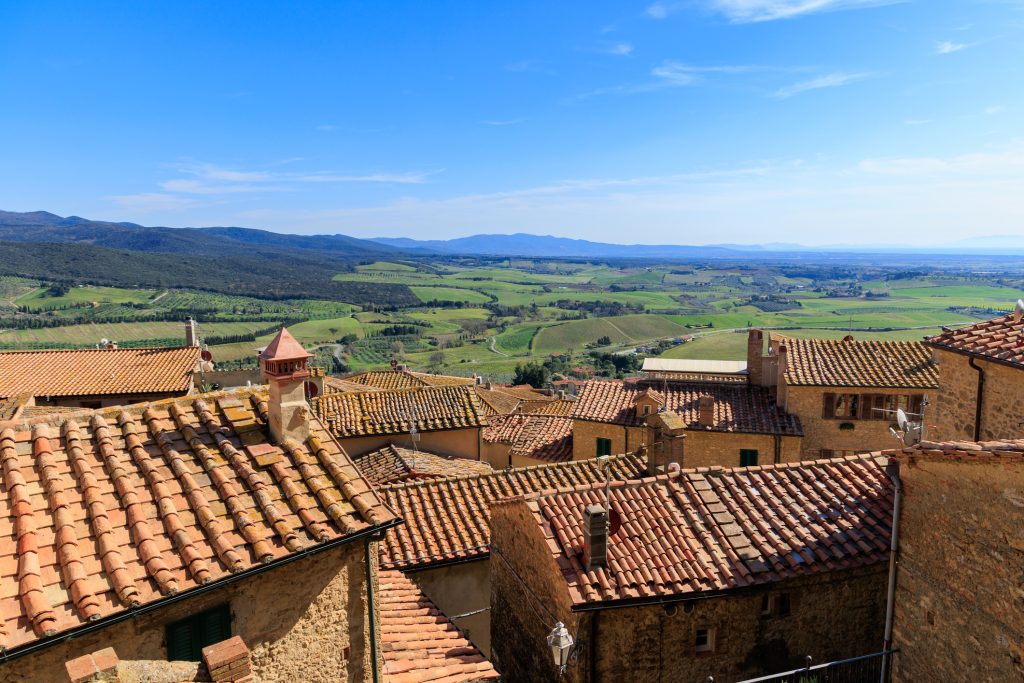
Glass
Ceramic glass is a mechanically strong and versatile material. It can sustain vast temperature changes and is not porous, making it an ideal material for common cooktops and cookware. Less common manufactured glass ceramic goods include engineering components, insulation, and telescopic mirrors.
Brick
Bricks are produced by mixing clay with water, shaping and forming the brick, then drying and firing. Bricks are common building materials for walls, chimneys, fireplaces, and more.
Silicon
Silicons are abundant natural materials and are commonly found in ceramic materials, from bricks to glass ceramic to porcelain.
Carbide
Carbide ceramics are resistant to heat, abrasion, and corrosion. They are mainly used in mechanical engineering, chemical, and power engineering, microelectronics as well as space engineering. Three examples of ceramic carbides are silicon, titanium, and tungsten. They are used to create mechanical seals, machining tools, ammunition, recreational equipment, and more.
The History of Ceramics: From Ancient Times to Modern Art
Ceramics, the art of shaping and firing clay, is one of humanity’s oldest and most enduring crafts. From ancient civilizations to contemporary studios, ceramics have played a significant role in daily life, culture, and art. This section explores the fascinating journey of ceramics from ancient times to the modern era, highlighting key developments and innovations that have shaped this timeless art form.
Ancient Beginnings
The history of ceramics begins with the earliest human settlements. Archaeological evidence shows that ceramic artifacts date back to at least 24,000 BCE. These early pieces, primarily found in what is now the Czech Republic, were small figurines known as Venus figurines. These objects were likely used in rituals or as symbols of fertility and prosperity.
The first known functional ceramics, such as pots and bowls, emerged around 10,000 BCE during the Neolithic period. These early ceramic pieces were hand-formed and fired in rudimentary kilns. The development of pottery was closely linked to the advent of agriculture, as people needed durable containers to store and cook food. The Jomon culture in Japan, which dates back to around 14,000 BCE, is renowned for its early pottery, characterized by intricate cord-marked designs.
Dogū were produced by the Jōmon people, one of the earliest known pottery-making cultures in the world. Hunter-gatherers who lived in the Japanese archipelago between 14,000 and 300 BC, their human- and animal-shaped ceramic figurines are astonishingly sophisticated, detailed, and diverse.
They’re also mysterious. Though archaeologists first uncovered dogū in the late 19th century, there’s still little consensus on their purpose or meaning. While sometimes associated with burials, which could indicate they played a part in religious or funerary rites, they have been discovered in a broad range of other archaeological contexts that make their classification difficult.
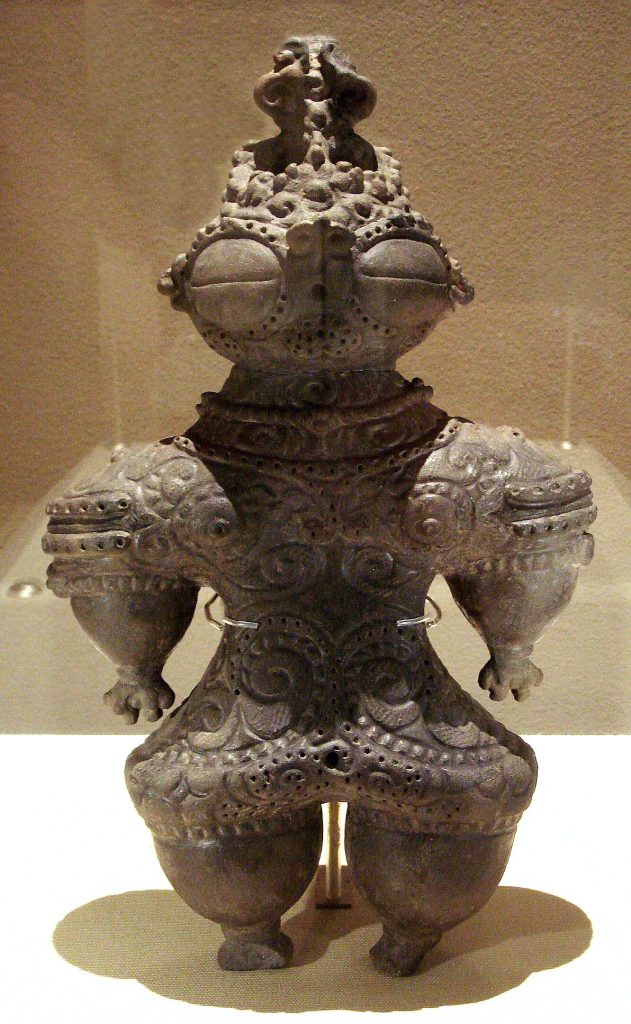
Mesopotamia
Mesopotamia, often referred to as the “Cradle of Civilization,” played a crucial role in the development of ceramics. Situated between the Tigris and Euphrates rivers, this region saw the rise of some of the world’s earliest and most influential cultures, including the Sumerians, Akkadians, Babylonians, and Assyrians.
Mesopotamian potters were pioneers in many ceramic techniques that laid the groundwork for future advancements. Around 3500 BCE, they began using the potter’s wheel, a revolutionary invention that allowed for more uniform and finely crafted pottery. This innovation significantly increased the efficiency and quality of ceramic production.
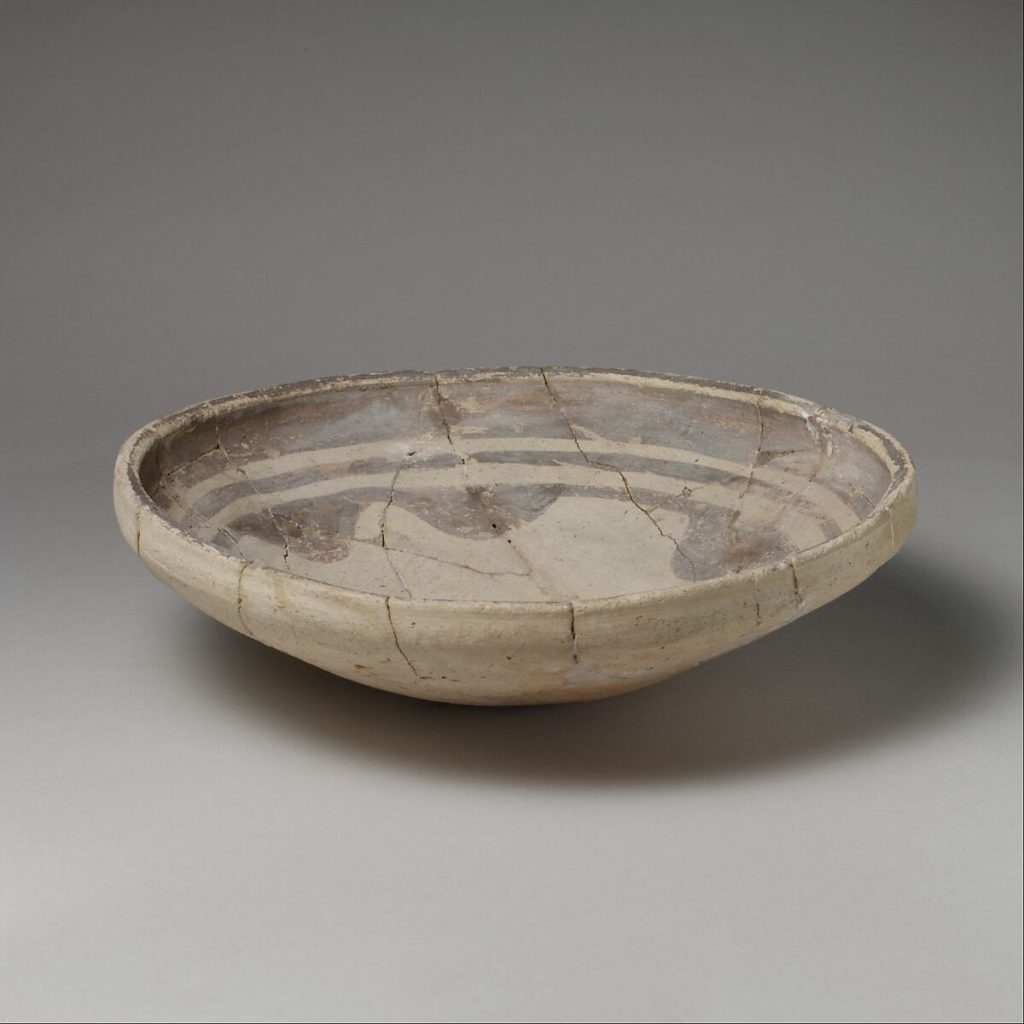
Mesopotamian ceramics were not only functional but also highly decorative. They often featured intricate geometric patterns and stylized representations of plants, animals, and mythological scenes. These designs were typically incised or painted on the surfaces of the pottery, then covered with a slip or glaze to enhance their durability and aesthetic appeal.
In the period 5500–4000 B.C., much of Mesopotamia shared a common culture called Ubaid, after the site where evidence for it was first found. Characterized by a distinctive type of pottery, this culture originated on the flat alluvial plains of southern Mesopotamia (ancient Iraq) around 6200 B.C.
This dish is decorated with a dark brownish paint in three concentric rings. The band around the rim is the widest, while the inner ring is ornamented with three groups of double half-moons in solid paint facing the center of the dish. The dark-painted pale pottery characteristic of the Ubaid period has been found throughout Mesopotamia. It originated in the south and then spread north and west. Over time the designs changed, which helps archaeologists to date sites where it is found.
Ancient Civilizations and Ceramics
As human societies evolved, so did the techniques and styles of ceramics. The ancient Egyptians, Greeks, and Chinese were particularly influential in the development of ceramic art.
Egyptian Ceramics
The ancient Egyptians produced a wide range of ceramics, including utilitarian vessels, decorative items, and funerary objects. Egyptian pottery was often adorned with vibrant colors and intricate designs, depicting scenes of daily life, mythology, and the natural world. Faience, a type of glazed ceramic, was a notable Egyptian innovation used to create small figurines and amulets.
Greek Ceramics
Greek pottery is celebrated for its aesthetic beauty and technical sophistication. The Greeks developed various pottery styles, including the famous black-figure and red-figure techniques. These styles involved painting scenes from mythology, daily life, and athletic competitions on the surface of the pots. Greek pottery was highly valued and widely traded throughout the Mediterranean.
Chinese Ceramics
China’s ceramic tradition is among the oldest and most influential in the world. Early Chinese pottery dates back to the Neolithic period, with notable examples including the distinctive black pottery of the Longshan culture. During the Han dynasty (206 BCE–220 CE), Chinese potters developed high-fired ceramics, such as stoneware and porcelain. The Tang (618–907 CE) and Song (960–1279 CE) dynasties saw the refinement of porcelain, which became highly prized both domestically and internationally.
Making Greek Vases (4:19)
The Middle Ages and Renaissance
During the Middle Ages, Islamic potters made significant contributions to ceramic art. They developed sophisticated glazing techniques and intricate geometric and floral designs. Islamic ceramics were highly influential, impacting European pottery through trade and cultural exchanges.
In Europe, the Renaissance period (14th–17th centuries) marked a revival of interest in classical art and culture, including ceramics. Italian maiolica, a tin-glazed pottery, became particularly popular. Maiolica featured bright colors and elaborate designs, often depicting scenes from mythology and daily life. The Renaissance also saw the emergence of Delftware in the Netherlands, a type of tin-glazed pottery inspired by Chinese porcelain.
The Age of Industrialization
The industrial revolution of the 18th and 19th centuries brought significant changes to ceramic production. Advances in technology and the development of new materials led to mass production and greater accessibility of ceramic goods.
Wedgwood
One of the most notable figures of this period was Josiah Wedgwood, an English potter and entrepreneur. Wedgwood’s innovations in ceramic production, such as the use of industrial techniques and marketing strategies, revolutionized the industry. He is best known for his development of jasperware, a type of stoneware with intricate relief decorations.
Porcelain
During this time, European potters perfected the production of porcelain, which had been a closely guarded secret of the Chinese for centuries. The Meissen porcelain factory in Germany and the Sèvres porcelain factory in France became renowned for their high-quality porcelain wares.
Modern and Contemporary Ceramics
The 20th and 21st centuries have seen a resurgence of interest in ceramics as an art form. Contemporary ceramic artists continue to explore the boundaries of the medium, pushing the limits of technique and creativity.
Studio Pottery
The studio pottery movement, which began in the early 20th century, emphasized the role of the individual artist in the creation of ceramics. This movement was characterized by a focus on handmade, one-of-a-kind pieces rather than mass-produced goods. Influential figures in this movement include Bernard Leach and Hamada Shoji, who blended Western and Eastern ceramic traditions.
Abstract and Experimental Ceramics
In the mid-20th century, artists such as Peter Voulkos and Lucie Rie began to treat ceramics as a sculptural medium, creating abstract and experimental works that challenged traditional notions of pottery. These artists used unconventional techniques and forms, often incorporating elements of modern art and design.
Sustainable and Functional Ceramics
Today, there is a growing emphasis on sustainability and functionality in ceramics. Many contemporary ceramic artists are committed to using environmentally friendly materials and processes. Additionally, there is a renewed interest in creating functional ceramics that enhance everyday life, from beautifully crafted tableware to innovative architectural ceramics.
Conclusion
The history of ceramics is a rich and diverse tapestry that spans thousands of years and countless cultures. From the earliest hand-formed pots to the intricate porcelains of ancient China and from the mass-produced wares of the Industrial Revolution to the avant-garde creations of contemporary artists, ceramics have continually evolved while maintaining their core essence of combining beauty and utility.
If you would like to explore more resources on ceramics, visit:
- Pottery Through History (A visual reference)
- AccessCeramics (a contemporary ceramics image resource. Browse by artist, material, or technique)
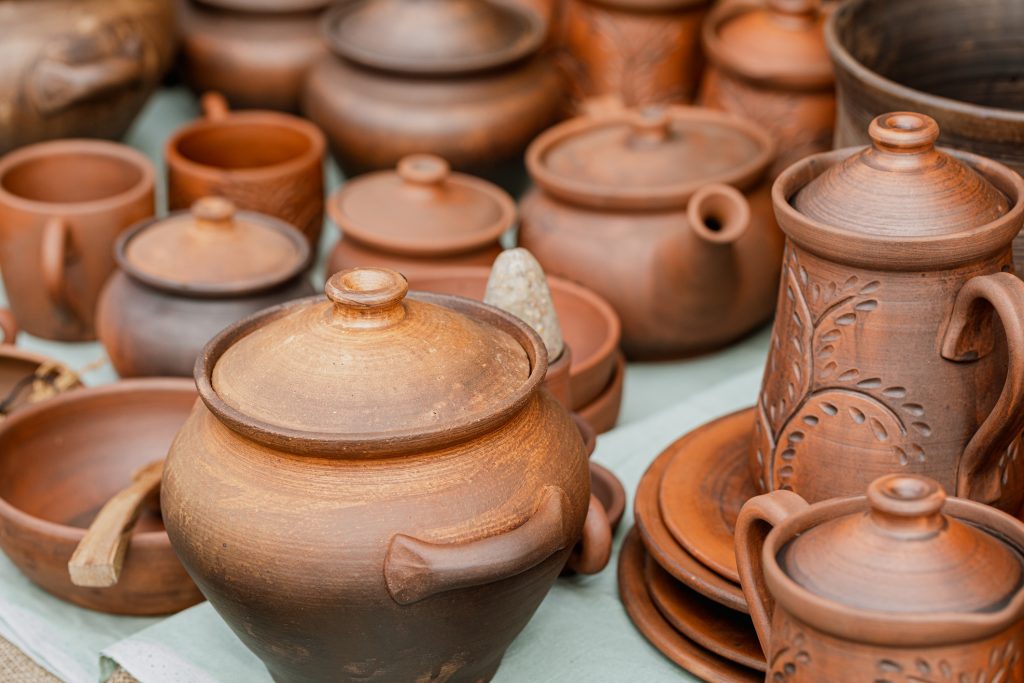
A summary of the most relevant milestones in the history of ceramics and glass is provided in the table below, provided by Ceramics.org.
Summary of History of Ceramics and Glass
| Year | Development |
|---|---|
| 28,000 BCE | Ceramic figurines are used for ceremonial purposes. |
| 18,000 BCE | Chinese pottery appears. |
| 18,000 BCE to 14,000 BCE | Ceramic pottery spreads in Eastern Asia. |
| 9,000 BCE | Ceramic products, such as vases, bricks, and tiles, become popular in the Middle East and Europe. |
| 7,000 BCE | Sharp tools made from natural glass appear. |
| 5,000 BCE | Phoenician merchants possibly make the first glass. |
| 3,500 BCE | Simple glass items are fabricated in Mesopotamia and Egypt. |
| 3,500 BCE | The wheel is invented, which will later be applied in wheel-forming of pottery. |
| 3,000 BCE | Glazed pottery is produced in Mesopotamia. |
| 1,500 BCE | Egyptians start building factories for production of glassware. |
| 700 BCE | Ceramic pottery becomes artwork in Attic Greece. |
| 600 CE | 600 CE Chinese introduce porcelain. |
| 1400s | High-temperature furnaces are developed in Europe for metallurgical use. |
| 1500s | High-temperature refractory materials are introduced to build furnaces for making steel, glass, ceramics, and cements, leading the way to the industrial revolution. |
| Mid 1800s | Porcelain electrical insulators and incandescent light bulbs are invented. |
| 1920s | High-strength quartz-enriched porcelain for insulators, alumina spark plugs, glass windows for automobiles, and ceramic capacitors are introduced. |
| 1940s | Research on oxide magnetic materials (ferrites) and ferroelectric materials begins. |
| 1950s | Ceramic capacitors based on barium titanate are developed. |
| 1960s | Alumina insulators for voltages over 220 kV are introduced and applications for carbides and nitrides are developed. The first yttria-based transparent ceramic is invented. Bioglass is also discovered. |
| 1970s | Partially stabilized zirconia is developed. High-performance cellular ceramic substrates for catalytic converter and particulate filters for diesel engines are commercialized. |
Media Attributions
- Figure 1. Planting pots are good examples of terracotta earthenware (Image courtesy of Getty).
- Figure 2. A set of Chinese-style porcelain pottery (image courtesy of Getty).
- Figure 3. A Tuscan town with rooftops composed of ceramic tiles (image courtesy of Getty)
- Figure 4. Dogū, Ebisuda site in Tajiri, Miyagi Prefecture, 1000–400 BC (image courtesy of World Imaging/Wikimedia Commons, 2008).
- Figure 5. Bowl, Period: Ubaid, Date: mid 6th–5th millennium BCE, Geography: Mesopotamia, Eridu (modern Abu Shahrein), Culture: Ubaid, Medium: Ceramic. Dimensions: 2 11/16 × 9 9/16 × 9 9/16 in. (6.9 × 24.3 × 24.3 cm) (Image source: Metropolitan Museum of Art collection, for educational use only).
- Figure 6. Traditional ethnic earthenware pottery (image courtesy of Getty).

